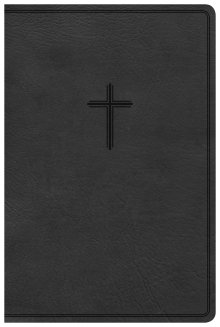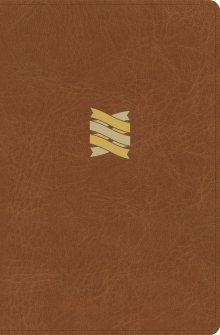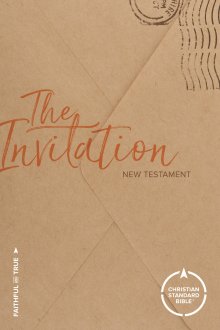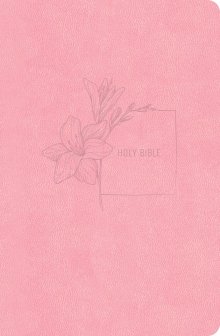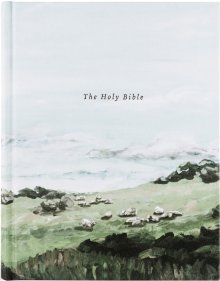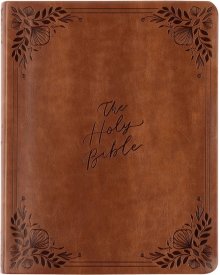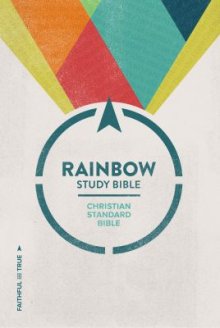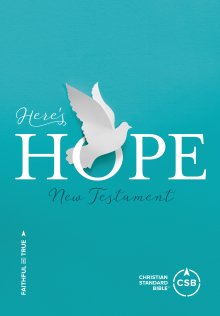What is the CSB Bible?
Aaron Lewendon - Eden Bibles & Bible Study Specialist

What is the Christian Standard Bible (CSB)? A Complete Guide
Choosing a Bible can feel like a huge decision. With a sea of acronyms like NIV, ESV, KJV, and NLT, how do you find the one that’s right for you? If you’re looking for a modern translation that is trustworthy, readable, and versatile, you’ve likely come across one of the fastest-growing and most respected translations available today: the Christian Standard Bible (CSB).
But what exactly is it?
Let's explore what makes the CSB unique and help you decide if it's the right Bible for your journey.
The Mission: What is the CSB?
The Christian Standard Bible is a modern English translation of the Bible, first published in 2017. A team of over 100 scholars from 17 different Christian denominations worked together with a single goal: to create a Bible that is as faithful as possible to the original languages, while also being exceptionally clear and readable for a modern audience.
The CSB's tagline is "Faithful and True," which perfectly captures its mission to be both reliable for deep study and enjoyable for daily reading.
The "Optimal Equivalence" Philosophy: The Best of Both Worlds
The real defining feature of the CSB is its unique translation philosophy: Optimal Equivalence.
To understand what this means, it helps to know the two traditional paths of Bible translation:
- Word-for-Word (Formal Equivalence): This method translates each word as literally as possible. It’s great for academic study but can sometimes sound clunky or unnatural. (Examples: KJV, ESV).
- Thought-for-Thought (Dynamic Equivalence): This method focuses on translating the main idea of a passage in a way that is easy to understand. It’s very readable but less precise about the specific words used. (Example: NLT).
Optimal Equivalence carves a brilliant middle path. The CSB translators started with a literal, word-for-word rendering. Then, they asked, "Is this clear in modern English?" If it was, the literal text remained. If it wasn't, they adjusted it to be more readable, while staying as close as possible to the original wording.
This balanced approach means you get a Bible that is accurate enough for sermon prep and trustworthy enough for deep study, all without sacrificing the smoothness that makes you want to read it every day.
How Does the CSB Compare to Other Bibles?
This is one of the most common questions readers have. Here’s a quick comparison with the main alternatives:
- CSB vs. NIV: The NIV is a "thought-for-thought" translation. The CSB is generally more literal and word-for-word than the NIV, offering a bit more precision while maintaining a similar level of readability.
- CSB vs. ESV: The ESV is a "word-for-word" translation. The CSB is more readable and uses more contemporary language than the ESV, making it sound less formal and a little smoother to the modern ear.
- CSB vs. KJV: The KJV is a beautiful, historic "word-for-word" translation from a different era of English. The CSB is much easier for a modern reader to understand as it uses today's vocabulary and grammar and is translated from the most up-to-date manuscripts.
- CSB vs. NLT: The NLT is a very readable "thought-for-thought" translation. The CSB is significantly more literal than the NLT, making it a better choice for those who want to do an in-depth study alongside their devotional reading.
Compare the Translations
Who is the CSB For?
Because of its unique balance, the CSB is an excellent fit for almost anyone. It has become particularly popular with:
- Pastors and Teachers who need a text that is accurate for teaching but also clear for their congregation to understand.
- Students of the Word who want to go deeper into the text without needing to decipher archaic language.
- New Believers who need a Bible that is accessible and easy to read from day one.
- Every day Readers who want a single Bible they can use for every aspect of their spiritual life.
Finding the Right CSB for You
The CSB comes in many different editions, each designed to help you engage with God's Word in a specific way.
- CSB Study Bibles: Perfect for those who want to dig deeper. These Bibles are filled with extensive notes, maps, articles, and character profiles to give you historical and theological context.
- CSB Devotional Bibles: Ideal for guiding your quiet time. These editions pair the scripture with daily readings, reflections, and prayers to help you apply God's Word to your life.
- CSB Compact Bibles: For God's Word on the go. These smaller, portable editions are perfect for taking with you to work, on your commute, or on your travels.
Frequently Asked Questions
Is the CSB a Catholic Bible? No, the CSB is not a Catholic Bible. It is a Protestant translation and does not include the Deuterocanonical books (or Apocrypha) that are part of the Catholic canon.
Who publishes the CSB? The CSB is published by Holman Bibles (B&H Publishing Group), the trade publishing arm of Lifeway Christian Resources.
Conclusion: A Bible You Can Trust and Enjoy
The Christian Standard Bible (CSB) is a modern English Bible translation known for its "Optimal Equivalence" philosophy, which balances word-for-word accuracy with thought-for-thought readability, making it a versatile choice compared to translations like the NIV, ESV, or KJV.
The Christian Standard Bible has earned its place as a major, modern translation because it solves the age-old problem of choosing between accuracy and readability. It offers a refreshing, trustworthy, and clear text that can serve as a lifelong companion for your walk with God.
Ready to experience it for yourself? Explore our complete collection of CSB Bibles here.
Latest Blogs

Bible
30+ Powerful Quotes About the Bible (For Inspiration in 2026)
Looking for inspiration? Discover a curated collection of the most powerful quotes about the Bible, from famous historical figures to modern theologians and Scripture itself.

Bibles
What is the "Standard" Bible for Christians?
Is there an "official" Bible that all Christians use? We explain the difference between the NIV, KJV, and ESV, and help you find the standard text for your church or personal reading.

Bible
"I Keep Failing to Read the Bible" – 5 Tips to Make the Habit Stick
Do you start a Bible reading plan only to quit a few weeks later? Stop the cycle of guilt. Here are 5 psychological tips and practical changes to help you build a Bible habit that actually lasts in 2026.

Bible
Where to Start Reading the Bible (5 Great Books for Beginners)
Confused about where to start reading the Bible? Don't start at page one! Here are the 5 best books for beginners to start with, from the action of Mark to the wisdom of Proverbs.

Bible
How to Start Reading the Bible for the First Time
Feeling overwhelmed by the Bible? You are not alone. Here is a simple, jargon-free guide on where to start, which translation to choose, and how to make sense of it all.

Bible
How to Read the Bible in a Year (A Simple 15-Minute Daily Plan)
A practical breakdown showing that reading the entire Bible in a year requires only 15 minutes a day, with tips on how to fit this simple habit into your daily routine.











